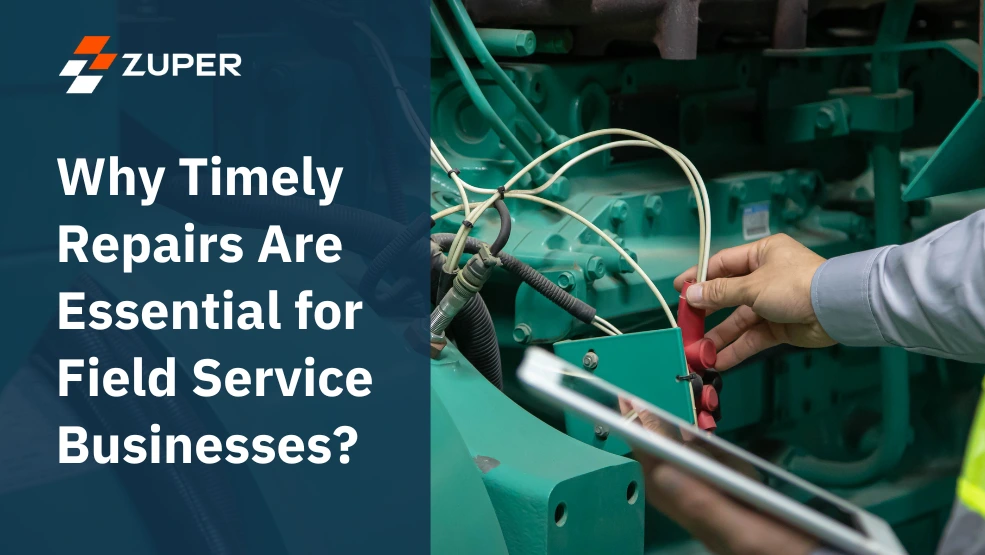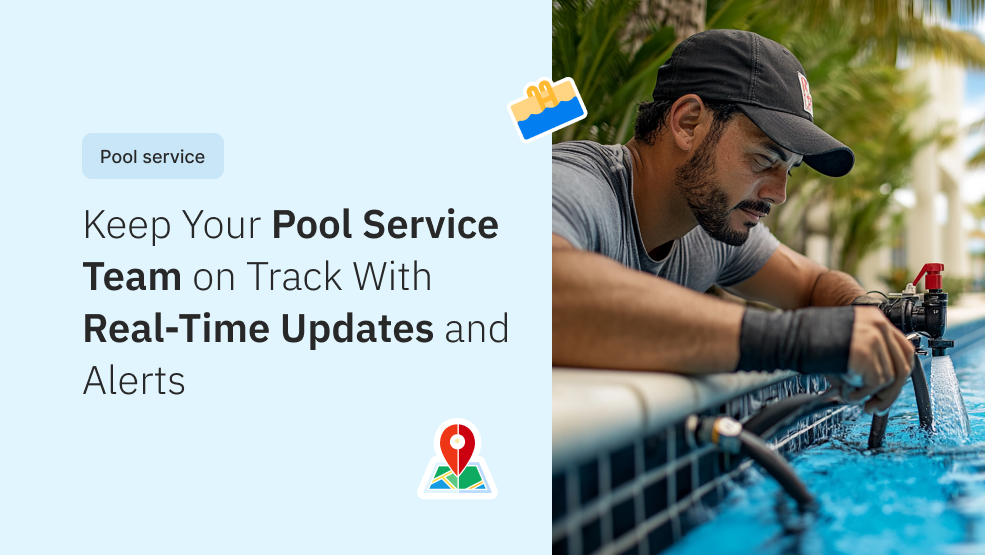You have been building your field service business for years and have developed a loyal customer base, but you know you could be doing better. Despite your best efforts, you still struggle with consistently delivering great service, especially regarding emergency services and repairs. How you handle issues in the field significantly impacts your bottom line.
Customers expect a prompt response and resolution when they call with an urgent problem. If you drag your feet or seem unprepared, your customer may lose faith in you, and you risk losing forever. On the other hand, building a reputation for fast, reliable service emergency services will put your customers’ minds at ease as they have confidence in your ability to deliver. The good news is with some planning and the right mindset, you can transform your field operations to enhance operational efficiency, make informed decisions, and boost customer satisfaction.
The high costs of equipment failures in field operations
The costs of equipment failures and downtime in field operations can be substantial. When equipment breaks down on site, your technicians end up spending time troubleshooting and creating make-shift fixes—just to get up and running again. These fixes are often temporary, requiring follow-up visits to address the problem correctly. These additional visits reduce operational efficiency and increase costs.
Emergencies also mean sending technicians out for unplanned service calls, diverting them from scheduled appointments. Additional service calls translate into paying employees for extra hours, and your customers end up waiting longer for service. Some customers may even cancel or take their business elsewhere due to delays.
The solution? You can avoid many of the costs associated with unplanned downtime. You can keep your field operations running smoothly with proactive maintenance, backup equipment, emergency preparedness, and fast response time.
Benefits of preventive maintenance and timely repairs
Preventing loss of productivity: The faster you can get technicians out to handle issues, the less downtime for your customers. You can have less disruption to your business and daily maintenance activities. Minimizing delays will improve productivity for both your company and your customers.
Increasing customer satisfaction: Nothing frustrates customers more than waiting for service technicians to arrive, especially in an emergency. Prioritizing rapid response and resolution of problems will significantly boost satisfaction and loyalty. Customers will appreciate your promptness and reliability.
Cost savings: The longer equipment or systems are down, the more it costs in lost time, wasted resources, and potential damage. Quickly diagnosing and fixing issues helps increase cost savings for your business and your customers. It also decreases the likelihood of needing expensive emergency repairs or replacements down the road.
Maintaining a competitive edge: In a sea of service providers, speed and competence make a difference. A reputation for fast, quality work, especially in a crisis, will set you apart. It gives you a key advantage for attracting and retaining customers who want a partner they can truly count on when the chips are down.
Steps to identify potential issues before they become emergencies
Waiting until equipment fails completely can seriously impact productivity, customer satisfaction, and profits. Instead, implement a proactive maintenance and inspection program to catch problems early on. Perform routine equipment maintenance according to the manufacturer’s recommendations.
Sticking to a regular schedule will help extend the working life of your equipment and reduce unplanned downtime. Conduct frequent inspections of equipment, vehicles, and tools. Have technicians thoroughly check over everything they use daily or weekly, noting any signs of wear or damage. Technicians should report issues immediately so repairs or replacements can be made quickly.
Monitor equipment performance and usage to identify irregularities. Unusually high or low meter readings, error codes, decreased efficiency, or output can all signal potential problems. Investigating abnormalities will help determine whether proactive service or replacement is needed. The sooner poor performance issues are addressed, the less impact they will have on your operations.
Developing emergency response plans to minimize downtime
Any service business must develop emergency response plans to minimize costly downtime and keep operations running smoothly. Emergencies can range from vehicle breakdowns, technology failures, natural disasters, or sudden staff shortages. Having a plan in place will allow you to address issues promptly and get your business back up and running.
Vehicle and equipment failure
Mechanical issues are inevitable for service businesses that rely on vehicles and equipment. Make sure you have backup options available, whether renting temporary replacements or having spare parts on hand for quick repairs. Map out alternative transport routes and methods in case primary options become unavailable. Regular maintenance and inspections can also help detect potential problems early.
Technology disruptions
Technology plays a significant role in scheduling, routing, and communications for most service businesses. Server crashes, software glitches, and network outages can grind operations to a halt. Implement automatic data backup systems, emergency communication plans, and temporary workaround procedures. Provide employees with training to handle tech issues and get systems functioning as quickly as possible.
Staffing shortages
Staff absences or resignations with little notice can be difficult to manage and accommodate. Develop relationships with temporary agencies and freelancers who can fill in when regular employees are unavailable on short notice. Cross-train technicians so others can perform essential duties in an emergency.
Natural disasters
Events like extreme weather, fires, or floods can damage property, restrict access, or cut off utilities. Work with local emergency management officials to develop response plans and stay up to date with the latest recommendations. Ensure you have means of communicating with both employees and customers in disastrous scenarios.
Planning for various emergencies can minimize downtime, continue serving your customers, and safeguard your business operations. Developing comprehensive yet flexible response strategies will give you the means to act quickly when the unexpected occurs. With the right solutions in place, you can enhance your service efficiency and maintain your competitive edge.
Strategies for Improving Field Service Operations Efficiency
Emergency preparedness
Be ready for the unexpected. Have emergency response plans and procedures in place and redundancies built into your systems and staffing. Make sure your technicians are properly trained to handle emergency situations. When emergencies inevitably arise, your ability to respond quickly and effectively is the major thing that greatly impacts customer satisfaction.
Streamlined dispatching
Invest in technology, tools, and field service management software that simplify dispatching technicians, optimize routes, and keep technicians on schedule. GPS tracking and routing software can help ensure the closest technician responds to each service call. Automated scheduling software allows you to book appointments efficiently, reducing confusion and missed commitments.
Continuous improvement
Regularly evaluate how technicians are performing, how long maintenance and repairs take, how many return visits are needed, and what percentage of issues are resolved on the first visit. Look for ways to minimize waste, reduce job completion times, decrease repeat calls, and increase first-time fix rates. Provide ongoing training to help technicians improve skills and adopt best practices. Data analytics tools are helpful when it comes to tracking and monitoring the performance of technicians.
Incentives and accountability
Consider implementing incentive programs that reward technicians for high productivity, on-time arrival, first-time fix rates, and exceptional customer service. Also, hold technicians accountable for meeting key performance indicators to encourage efficiency and professionalism. Incentives and accountability are powerful motivators for optimizing field operations.
Following these strategies will significantly enhance your service business’s responsiveness, productivity, and customer satisfaction. By focusing on emergency preparedness, optimized dispatching, continuous improvement, and incentives with accountability, you can streamline field operations for maximum efficiency. Your investment in these areas will pay off through increased profitability, a superior customer experience, and a competitive advantage.
Final thoughts
The key to boosting efficiency and keeping your customers happy in a service business is all about responsiveness. By ensuring your team is equipped to handle repairs and emergencies promptly, you can minimize downtime and keep operations running smoothly. When issues arise, address them right away instead of putting them off until later. Your customers will appreciate your quick solutions and continued uptime. Your business will benefit from higher productivity, increased billable hours, and the ability to take on more work.
Keep an eye on our resources for your field service businesses for more tips like this in the future. Want to learn more about how to increase productivity and profitability? Let’s discuss how Zuper can help you with this.










